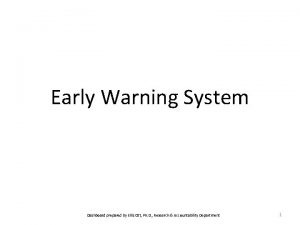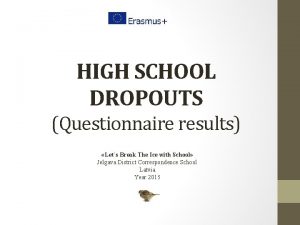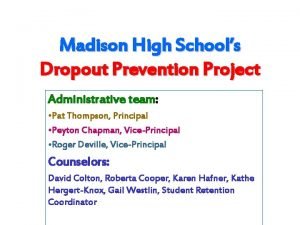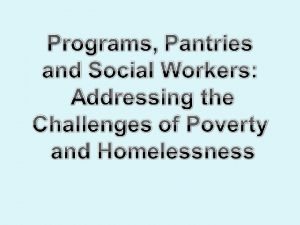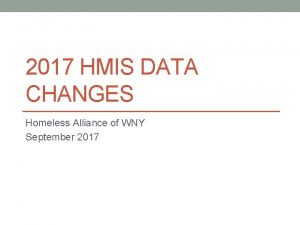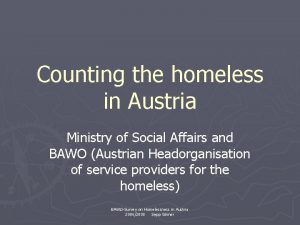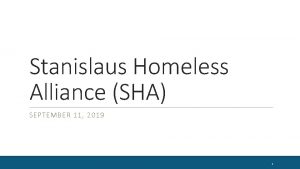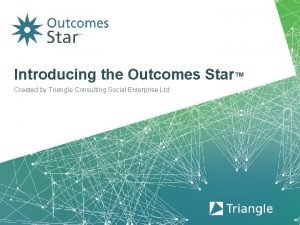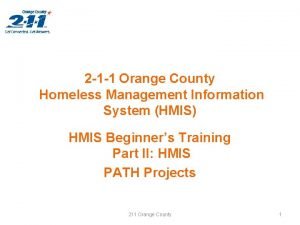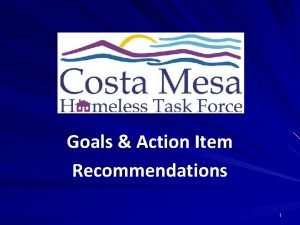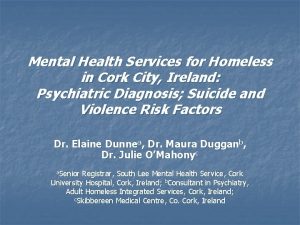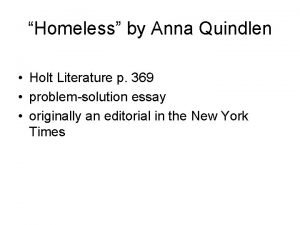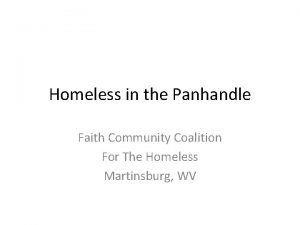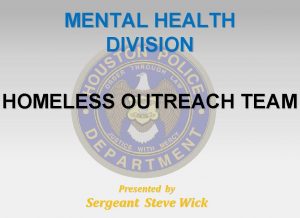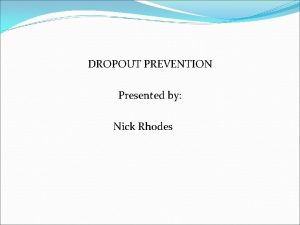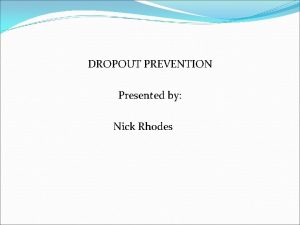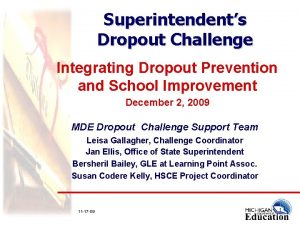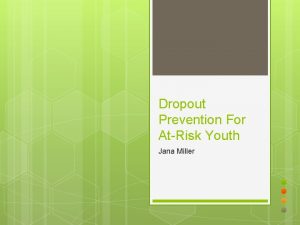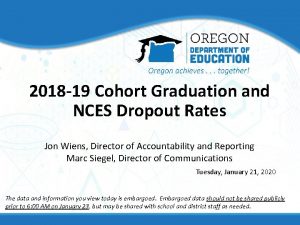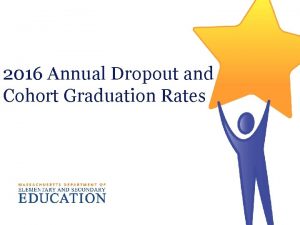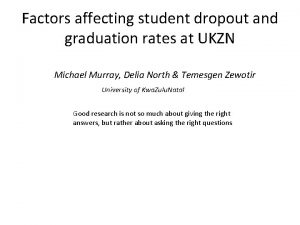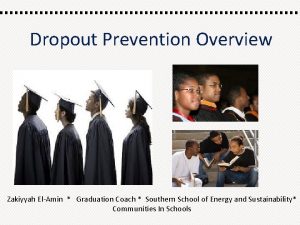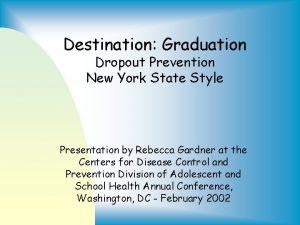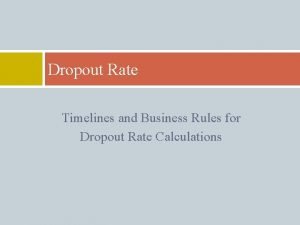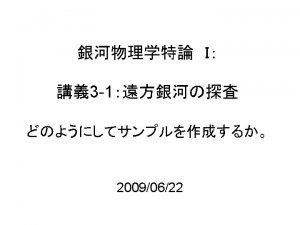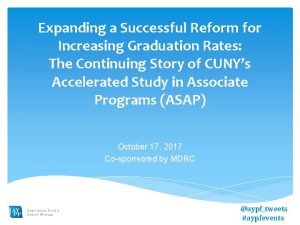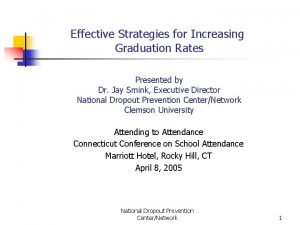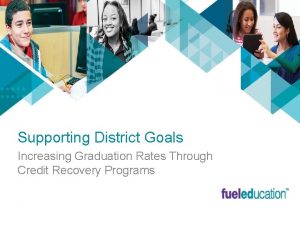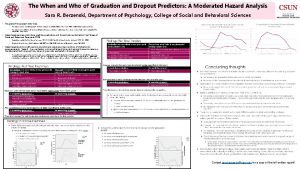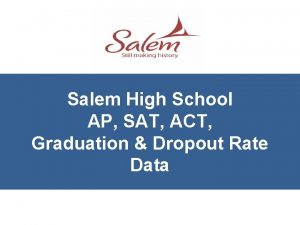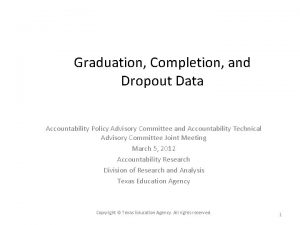DropOut Prevention Increasing Graduation Rates for AtRisk Homeless


















































- Slides: 50

Drop-Out Prevention: Increasing Graduation Rates for At-Risk, Homeless, Neglected and Delinquent Youth Quality of Life Conference Savannah, Georgia July 13, 2011 Eric Mc. Ghee, Grant Programs Manager Outreach Programs Division School Improvement Dr. John D. Barge, State School Superintendent “Making Education Work for All Georgians” www. gadoe. org

Content q. Overview of Title I, Part D § Subpart 1 § Subpart 2 q. Overview of Title X, Part C q. Graduation Rate Information q. Prevention & Intervention Strategies Dr. John D. Barge, State School Superintendent “Making Education Work for All Georgians” www. gadoe. org

Neglected, Delinquent and At-Risk Youth Education Program OVERVIEW OF TITLE I, PART D Dr. John D. Barge, State School Superintendent “Making Education Work for All Georgians” www. gadoe. org

Overview of Title I, Part D Neglected and Delinquent Children defined: q. Neglected = Children and youth who are in need of care due to abandonment, neglect, or death of their parents or guardians. q. Delinquent = Children who have been adjudicated to be delinquent or in need of supervision. Dr. John D. Barge, State School Superintendent “Making Education Work for All Georgians” www. gadoe. org

Overview of Title I, Part D The purpose of Title I, Part D is to: q Improve educational services for children and youth in local and state institutions for neglected and delinquent (N&D) students so that such students have the opportunity to meet the same challenging state academic content standards and challenging state student academic achievement standards that all children in Georgia are expected to meet; q Provide N&D students with the services needed to make a successful transition from institutionalization to further schooling or employment; and q Prevent at-risk youth from dropping out of school, and to provide dropouts, and children and youth returning from correctional facilities or institutions for neglected or delinquent children and youth, with a support system to ensure their continued education. Dr. John D. Barge, State School Superintendent “Making Education Work for All Georgians” www. gadoe. org

Overview of Title I, Part D Grantees and Population q. Title I, Part A § Provides financial assistance to LEAs and schools with high numbers or high percentages of poor children to help ensure that all children meet challenging state academic standards. q. Title I, Part D § Subpart 1 - Provides financial assistance to educational programs for youth in state-operated facilities or community day programs. § Subpart 2 - Provides financial assistance to support eligible LEA programs involving collaboration with locally operated correctional facilities. Dr. John D. Barge, State School Superintendent “Making Education Work for All Georgians” www. gadoe. org

Overview of Title I, Part D q Subpart 1 § Provides assistance for State Agencies v. Georgia Department of Juvenile Justice (DJJ) v. Georgia Department of Corrections (GDC) v. Georgia Department of Behavioral Health and Developmental Disabilities (DBHDD) q Subpart 2 § Provides assistance for LEAs v. Working in collaboration with local residential correctional facilities (In Georgia, O. C. G. A. 20 -2 -133(b) facilities MAY be eligible) Dr. John D. Barge, State School Superintendent “Making Education Work for All Georgians” www. gadoe. org

Overview of Title I, Part D Services for N&D Children q In general, the same allowable services provided under Title I are the same type of services provided to N&D residential facilities and children. q Resources provided to N&D residential facilities and children should supplement, and not supplant, the “regular” school program. q Services may include before and after school tutorials, summer school, credit recovery, educational materials and supplies, and more. Dr. John D. Barge, State School Superintendent “Making Education Work for All Georgians” www. gadoe. org

Overview of Title I, Part D Title I, Part A Set Aside Funding q US ED determines the LEA Title I, Part A neglected set-aside amount based on the neglected child count derived from the N&D Annual Survey. q LEAs must use the entire Title I, Part A neglected set-aside for N&D children, unless the LEA has written verification that the residential facilities do not need the entire amount – the unclaimed amount reverts back to Title I, Part A. q LEAs are required to consult with all N&D facilities located in the LEA’s school attendance area to determine needs. Dr. John D. Barge, State School Superintendent “Making Education Work for All Georgians” www. gadoe. org

Overview of Title I, Part D, Subpart 2 - Uses of Funds q Carry out high-quality education programs. q Assist in the transition of children and youth returning to the local “regular” school environment from correctional facilities and help them remain in school to complete their education. q Provide dropout prevention programs to serve at-risk children and youth. Dr. John D. Barge, State School Superintendent “Making Education Work for All Georgians” www. gadoe. org

Overview of Title I, Part D, Subpart 2 - Uses of Funds q Coordinate health and social services for N&D children, if the provision of such services will improve the likelihood of children completing their education. q Provide special programs to meet unique academic needs of N&D children. q Provide mentoring and peer mediation. Dr. John D. Barge, State School Superintendent “Making Education Work for All Georgians” www. gadoe. org

Mc. Kinney-Vento Act OVERVIEW OF TITLE X, PART C Dr. John D. Barge, State School Superintendent “Making Education Work for All Georgians” www. gadoe. org

Overview of Title X, Part C Program Purpose q Ensure homeless children and youth (HCY) have equal access to the same free, appropriate public education, including public preschool education, as provided to other children and youth. q Ensure access to education and other services needed to ensure that HCY have an opportunity to meet the same challenging state student academic achievement standards to which all students are held. q Facilitate the enrollment, attendance, and success in school of HCY. q Review and revise laws, regulations, practices, and policies that may act as barriers to the enrollment, attendance, and success in school of HCY. Dr. John D. Barge, State School Superintendent “Making Education Work for All Georgians” www. gadoe. org

Overview of Title X, Part C Definition of Homeless Students q Individuals whose nighttime residence is NOT: § Fixed—stationary, permanent, and not subject to change. § Regular—used on a predictable, routine, or consistent basis. § Adequate—sufficient for meeting both the physical and psychological needs typically met in the home. (42 U. S. C. § 11434 A(2)(B)(i)) Can the student go to the SAME PLACE (fixed) EVERY NIGHT (regular) to sleep in a SAFE AND SUFFICIENT SPACE (adequate)? Dr. John D. Barge, State School Superintendent “Making Education Work for All Georgians” www. gadoe. org

Overview of Title X, Part C The Homeless definition includes children and youth who are: q sharing the housing of other persons due to loss of housing, economic hardship, or similar reason; q living in motels, hotels, trailer parks, or camping grounds due the lack of alternative accommodations; q living in emergency or transitional shelters; q abandoned in hospitals; Dr. John D. Barge, State School Superintendent “Making Education Work for All Georgians” www. gadoe. org

Overview of Title X, Part C Homeless also includes children and youth who are: q awaiting foster care placement; q living in a primary nighttime residence that is a public or private place not designed for or ordinarily used as a regular sleeping accommodation for human beings; q living in cars, parks, public spaces, abandoned buildings, substandard housing, bus/train stations, or similar settings; q migratory – who qualify as homeless living in circumstances described above. Dr. John D. Barge, State School Superintendent “Making Education Work for All Georgians” www. gadoe. org

Overview of Title X, Part C Definition of Unaccompanied Homeless Youth (UHY) q Unaccompanied = not in the physical custody of a parent or guardian; in practical terms, this means the youth does not live with the parent or guardian. q 2 -Step Process: 1) Does the student’s living arrangement meet the Mc. Kinney-Vento Act’s definition of homeless? 2) Once homelessness is determined, is the student unaccompanied? Dr. John D. Barge, State School Superintendent “Making Education Work for All Georgians” www. gadoe. org

Overview of Title X, Part C q Unaccompanied youth have the same rights as other students experiencing homelessness. q Unaccompanied youth have run away from home, been thrown out of their homes, and/or been abandoned by parents or guardians. These young people are separated from their parents for a variety of reasons: § Over half report being physically abused at home. § Over one third report sexual abuse. § Over two-thirds report that at least one of their parents abuses drugs or alcohol. Dr. John D. Barge, State School Superintendent “Making Education Work for All Georgians” www. gadoe. org

Overview of Title X, Part C Resources to support children experiencing homelessness: q Title I, Part A Homeless Reservation (Set-Aside) § Same uses of funds allowed under Title I, Part A – to supplement the regular instruction that leads to a diploma. q Title X, Part C Mc. Kinney-Vento Grant § Same uses of funds allowed under Title I, Part A – to supplement the regular instruction that leads to a diploma. § A few other educationally-related expenses allowed. Dr. John D. Barge, State School Superintendent “Making Education Work for All Georgians” www. gadoe. org

Overview of Title X, Part C Authorized Activities: (Title I, Part A Homeless Set-aside and Title X, Part C) q Tutoring, supplemental instruction linked to challenging State content and achievement standards. q Expedited evaluations of strengths and needs. (e. g. , GATE, LEP, IDEA, Title I, School Nutrition etc. ) q Before/after-school programs, and summer programs. q Professional development for educators to promote understanding, sensitivity, and the educational rights of students. q Pupil services, including violence prevention counseling, and referral for services. q Payment of fees and other costs related to records. q Provision of other extraordinary or emergency assistance needed to enable school attendance. q Supplies and adaptation of space for non-school services. q Services and assistance to attract, engage, and retain students in schools. q Provision of school supplies, including those distributed at temporary housing and other appropriate locations. q Education and training for parents about rights and resources. Dr. John D. Barge, State School Superintendent “Making Education Work for All Georgians” www. gadoe. org

Overview of Title X, Part C Authorized Activities for Use of Grant Funds (Title X, Part C only) q Activities that address needs that may arise from domestic violence. q Early childhood education programs not otherwise provided through federal, state, or local funding. (May vary from state to state) q Assistance to defray the excess costs of transportation. These activities should not require funds: q Development of coordination between schools and agencies. q Referral services for medical, dental, mental health services. Dr. John D. Barge, State School Superintendent “Making Education Work for All Georgians” www. gadoe. org

Overview of Title X, Part C Unauthorized Activities/Expenditures include: q q q q Supplies for agencies. Computer/ equipment for agencies. Clothing (emergency basis only). Pre-paid phones. Grants administration. Full-time liaison salaries. Salaries for external evaluators/assessment personnel. Dr. John D. Barge, State School Superintendent “Making Education Work for All Georgians” www. gadoe. org

Overview of Title X, Part C Unauthorized Activities Consumer credit counseling services. q Rerouting of school buses. q Emergency assistance… § Utilities. § Rent. § Childcare. § Housing deposits. q Dr. John D. Barge, State School Superintendent “Making Education Work for All Georgians” www. gadoe. org

Georgia GRADUATION RATE INFORMATION Dr. John D. Barge, State School Superintendent “Making Education Work for All Georgians” www. gadoe. org

Graduation Rate Information The Cost of Dropping Out Nationwide Statistics q 7, 200 students drop out of U. S. public high schools every day and 342 are from Georgia. q Each year, approximately 1. 3 million students fail to graduate from high school and more than half are from minority groups. Dr. John D. Barge, State School Superintendent “Making Education Work for All Georgians” www. gadoe. org Diplomas Count, 2010 Retrieved from http: //www. edweek. org/media/ew/dc/20 10/DC 10_Press. Kit_FINAL. pdf

Graduation Rate Information The Cost of Dropping Out National & State Statistics q. Dropouts from the Class of 2008 alone will cost the nation more than $319 billion and will cost Georgia almost $15. 5 billion in lost wages over their lifetimes. July 2009 by the Alliance for Excellent Education Dr. John D. Barge, State School Superintendent “Making Education Work for All Georgians” www. gadoe. org

Graduation Rate Information The Cost of Dropping Out Nationwide Statistics q. Dropouts are more likely to experience higher rates of unemployment, a greater likelihood of living below the poverty line and relying on public assistance, and more frequent and severe health problems. q. High school dropouts are two times less likely to vote or participate in community service activities. Levin, Belfield, Muenning, & Rouse, 2007; SREB, 2005 Dr. John D. Barge, State School Superintendent “Making Education Work for All Georgians” www. gadoe. org

Graduation Rate Information The Cost of Dropping Out Nationwide Statistics q. High school dropouts are eight times more likely than high school graduates to be incarcerated in their lifetimes. q 86% of Georgia inmates do not have a high school diploma. q. If the male graduation rate were increased by only 5%, the nation would see an annual savings of $4. 9 billion in crime-related costs. Bridgeland, Dilulio, & Morison, 2006; GDC, 2007; SREB, 2005 Dr. John D. Barge, State School Superintendent “Making Education Work for All Georgians” www. gadoe. org

Graduation Rate Information The Cost of Dropping Out “The math simply does not work for Georgia” q$3, 800 per year on each K-12 student. q$6, 800 per year on each university student. q$18, 000 per year on each prison inmate. Governor Deal February 2011 Georgia Public Policy Foundation Dr. John D. Barge, State School Superintendent “Making Education Work for All Georgians” www. gadoe. org

Graduation Rate Information The Dropout Issue in Georgia q 20, 633 students dropped out in grades 7 -12 in 2009 -2010 school year. Belfantz & Letgers, 2004; Governor’s Office of Student Achievement 2009 -2010 Report Card Dr. John D. Barge, State School Superintendent “Making Education Work for All Georgians” www. gadoe. org

Graduation Rate Information How does Georgia calculate its high school graduation rate? q To comply with federal requirements, Georgia uses the National Center for Education Statistics (NCES) “Leaver Rate. ” 32 other states use this method. It defines a graduate as a student who leaves high school with a Regular Diploma in four years. This does not include Certificates of Attendance or Special Education Diplomas. Georgia’s Graduation Rate Formula: # of students who graduate with a regular diploma ÷ # of 9 th-12 th grade dropouts from appropriate years + graduates + other completers q The lack of unique statewide student identifiers has not allowed Georgia to track individual students across all four years of high school until recently; therefore, the graduation rate is a “proxy calculation” and reflects an estimate of the percentage of students who entered ninth grade and graduated four years later. Dr. John D. Barge, State School Superintendent “Making Education Work for All Georgians” www. gadoe. org

Graduation Rate Information 90. 0% 80. 0% 70. 0% 60. 0% 50. 0% 40. 0% 30. 0% 20. 0% 10. 0% Georgia 65. 4% 2004 78. 9% 80. 8% 75. 4% 69. 4% 70. 8% 72. 3% 2005 2006 2007 2008 2009 2010 Governor’s Office of Student Achievement (GOSA) Dr. John D. Barge, State School Superintendent “Making Education Work for All Georgians” www. gadoe. org

Graduation Rate Calculation Comparison Leaver/Proxy Rate vs. Cohort Rate Leaver/Proxy Rate Calculation for AYP 2003 -2011 Cohort Rate Calculation for Report Card 2011 and AYP 2012 > This rate does not track cohorts of students. Therefore, the This rate does track a cohort of students. Students who entered year a student enters the 9 th grade is not considered when 9 th grade for the first time during the 2007 -2008 (2008) school calculating the graduation rate. The Leaver/Proxy Rate formula year make up the cohort. is as follows: # of cohort students earning a regular diploma # of regular diplomas 1 st time 9 th graders in 2008 plus students who transfer in who belong to this cohort minus students who transfer out, emigrate # of regular diplomas + # of special ed. diplomas + # or die during 2008, 2009, 2010, & 2011 school years of certificates of attendance + 9 th grade dropouts (2008) + 10 th grade dropouts (2009) + 11 th grade dropouts (2010) + Dropout Withdrawal Codes: 12 th grade dropouts (2011) • B - Marriage Dropout Withdrawal Codes: • E - Expelled • B - Marriage • F - Financial Hardship/Job • E - Expelled • I - Incarcerated • F - Financial Hardship/Job • L - Low Grades • I - Incarcerated • M - Military • L - Low Grades • O - Adult Education • M - Military • P - Pregnant • O - Adult Education • R - Removed for Lack of Attendance • P - Pregnant • S - Serious Illness/Accident • R - Removed for Lack of Attendance • U – Unknown • S - Serious Illness/Accident 1. Students who take longer than 4 years and a summer to graduate • U – Unknown will not count in the numerator. 1. Active students are not pulled into the calculation. 2. Students who belong to the cohort and dropout remain in the 2. Students who graduate with a regular diploma impact denominator. the calculation during the school year in which they graduate. Dr. John D. Barge, State School Superintendent 3. Students who were coded as a dropout and are found to have subsequently enrolled will be re-coded as transfers. “Making Education Work for All Georgians” www. gadoe. org 4. Students who were coded as a transfer but cannot be found throughout the state will be re-coded as a dropout.

Graduation Rate Information Changes for future q Since 2003, Georgia has used the leaver method to calculate the graduation rate. q Georgia moving from the leaver method to a national cohort methodology that is considered more accurate. In 2012, Georgia plans to report their graduation rates using the Cohort formula. q Officials in Georgia expect that the graduation rate will drop 10 or more percentage points. Dr. John D. Barge, State School Superintendent “Making Education Work for All Georgians” www. gadoe. org

Increasing the Graduation Rate PREVENTION & INTERVENTION STRATEGIES Dr. John D. Barge, State School Superintendent “Making Education Work for All Georgians” www. gadoe. org

Prevention & Intervention Strategies Consider these facts about homeless children in the United States: q In one year, 42% transferred schools at least once. Of these, 51% transferred twice or more. q 28% will attend three or more different schools in one year. q With each change in schools, it is estimated that a student is set back academically by an average of four to six months. q Many lack basic school supplies and a reasonable environment in which to do homework. q Three quarters of older homeless students drop out of school. Dr. John D. Barge, State School Superintendent “Making Education Work for All Georgians” www. gadoe. org

Dr. John D. Barge, State School Superintendent “Making Education Work for All Georgians” www. gadoe. org

Prevention & Intervention Strategies Support at-risk students: q. Model positive and respectful behavior. q. Offer guidance, stability, and assistance in making intelligent, personal, and educational choices. q. Garner family and community support. q. Triage efforts of school leadership, teachers, and other student support staff to acquire resources, broker extra help, and address individual and collective challenges. Bridgeland, Dilulio, & Morison, 2006; Goldschmidt & Wang, 1999; Hammond, Linton, Smink, & Drew, 2007; Howard & Johnson, 2002; Ingels et al. , 2002; Tinto, 1987; Roderick, 1993; Wehlage, 1989; Wehlage et al. , 1989 Dr. John D. Barge, State School Superintendent “Making Education Work for All Georgians” www. gadoe. org

Prevention & Intervention Strategies Implement schoolwide support and interventions: q. Develop and implement credit recovery and alternative options, adapt curriculum, and differentiate instruction to meet the needs of identified at-risk students. q. Provide training and/or support to teachers on strategies that work with at-risk youth. Alexander, Entwisle, & Kabbani, 2001; Battin-Pearson et al. , 2000; Bridgeland, Dilulio, & Morrison, 2006; Ekstrom, Goertz, Pollack, and Rock, 1986; Jordan, Lara, & Mc. Partland, 1994; Wagner et al. , 1993 Dr. John D. Barge, State School Superintendent “Making Education Work for All Georgians” www. gadoe. org

Prevention & Intervention Strategies Provide Direct Service and Case Management: q. Develop and implement individual, small group, and whole school intervention and prevention strategies to help students stay in school and graduate. q. Create a graduation and career plan that can track progress and follow students from grade to ensure consistent support. q. Offer personal, academic, and career advisement. Berk, 2000; Bronfenbrenner, 1979; Myers, Varkey, & Aguirre, 2002; Schaffer, 2006 Dr. John D. Barge, State School Superintendent “Making Education Work for All Georgians” www. gadoe. org

Prevention & Intervention Strategies q Develop and maintain transition programs and vertical teams. q Assist in mediating conflicts, bridging communication gaps, brokering services, and negotiating bureaucracies among home, school, and community agencies. Bridgeland, Dililio, & Morrison, 2006; Elliot & Voss, 1974; Hammond, Linton, Smink, & Drew, 2007; Ingels et al. , 2002; Roderick, 1993 Dr. John D. Barge, State School Superintendent “Making Education Work for All Georgians” www. gadoe. org

Prevention & Intervention Strategies q Combat family, school, and community culture issues that may hinder a student’s chances of achieving educational success. q Develop cultures that value learning, hold high expectations for the scholastic outcomes of all students, and celebrate academic achievement. Dr. John D. Barge, State School Superintendent “Making Education Work for All Georgians” www. gadoe. org

Prevention & Intervention Strategies Georgia House Bill 400 – Bridges Legislation q Legislation focuses on students receiving quality career advisement and links the high school course work with their future college and career goals. q The implementation of the BRIDGE (Building Resourceful Individuals to Develop Georgia’s Economy) Act will become an integral part of a student’s educational plan this year. q The BRIDGE Act will help students and parents work together to enhance their child’s education to reach their goals and dream career. q The most critical part of this recently signed law is the requirement for all students in middle and high school to receive annual career guidance and advisement to choose a career area, create an Individual Graduation Plan and graduate high school prepared to go to college or enter the work force. Dr. John D. Barge, State School Superintendent “Making Education Work for All Georgians” www. gadoe. org

House Bill 400 Dr. John D. Barge, State School Superintendent “Making Education Work for All Georgians” www. gadoe. org

Dr. John D. Barge, State School Superintendent “Making Education Work for All Georgians” www. gadoe. org

Dr. John D. Barge, State School Superintendent “Making Education Work for All Georgians” www. gadoe. org

Prevention & Intervention Strategies The Individual Graduation Plan 1) Include rigorous academic core subjects and focused course work in mathematics and science or in humanities, fine arts, and foreign language or sequenced career pathway course work; 2) Incorporate provisions of a student's Individualized Education Program (IEP), where applicable; 3) Align educational and broad career goals and a student's course of study; 4) Be based on the student's selected academic and career focus area as approved by the student's parent or guardian; 5) Include experience based, career oriented learning experiences which may include, but not be limited to, internships, apprenticeships, mentoring, co-op education, and service learning; Dr. John D. Barge, State School Superintendent “Making Education Work for All Georgians” www. gadoe. org

Prevention & Intervention Strategies The Individual Graduation Plan 6) Include opportunities for postsecondary studies through articulation, dual enrollment, and joint enrollment; 7) Be flexible to allow change in the course of study, but be sufficiently structured to meet graduation requirements and qualify the student for admission to postsecondary education; and 8) Be approved by the student and the student's parent or guardian with guidance from the student's school counselor or teacher adviser. An individual graduation plan shall be reviewed annually, and revised, if appropriate, upon approval by the student and the student's parent or guardian with guidance from the student's school counselor or teacher adviser. An individual graduation plan may be changed at any time throughout a student's high school career upon approval. Dr. John D. Barge, State School Superintendent “Making Education Work for All Georgians” www. gadoe. org

Prevention & Intervention Strategies www. gacollege 411. org Dr. John D. Barge, State School Superintendent “Making Education Work for All Georgians” www. gadoe. org

Contact Information Eric Mc. Ghee Grant Programs Manager School Improvement Twin Towers East, Suite 1866 205 Jesse Hill Jr. Drive SE Atlanta, GA 30334 (404) 651 -7555 - Office (404) 657 -1534 - Fax emcghee@doe. k 12. ga. us Dr. John D. Barge, State School Superintendent “Making Education Work for All Georgians” www. gadoe. org
 Primary prevention secondary prevention tertiary prevention
Primary prevention secondary prevention tertiary prevention Southampton city council housing
Southampton city council housing Equivalent ratios definition
Equivalent ratios definition Ratios rates and unit rates
Ratios rates and unit rates Ratios rates and unit rates
Ratios rates and unit rates A rate is a ratio
A rate is a ratio Ott dropout
Ott dropout College dropout review
College dropout review Questionnaire on school dropouts
Questionnaire on school dropouts Dropout 線上看
Dropout 線上看 Daniel craig homeless
Daniel craig homeless Homeless alliance of wny
Homeless alliance of wny Hunchback in the park analysis
Hunchback in the park analysis Homelessness in austria
Homelessness in austria Stanislaus homeless alliance
Stanislaus homeless alliance Dogooder consulting
Dogooder consulting Homeless to harvard questions
Homeless to harvard questions Chronically homeless orange county
Chronically homeless orange county Homeless shelters southend
Homeless shelters southend How to dress homeless
How to dress homeless Costa mesa homeless
Costa mesa homeless Homeless artinya
Homeless artinya Thomas benjamin kennington
Thomas benjamin kennington Homeless services cork
Homeless services cork Michael oher homeless
Michael oher homeless Home stretch alameda county
Home stretch alameda county Homeless anna quindlen
Homeless anna quindlen Homeless coalition martinsburg wv
Homeless coalition martinsburg wv Hpd homeless outreach team
Hpd homeless outreach team Returpilarna
Returpilarna Rita perspektiv
Rita perspektiv Formuö
Formuö Redogör för vad psykologi är
Redogör för vad psykologi är Gumman cirkel
Gumman cirkel Bästa kameran för astrofoto
Bästa kameran för astrofoto Svenskt ramverk för digital samverkan
Svenskt ramverk för digital samverkan Korta dikter som rimmar
Korta dikter som rimmar Nyckelkompetenser för livslångt lärande
Nyckelkompetenser för livslångt lärande Kvinnlig mantel i antikens rom
Kvinnlig mantel i antikens rom Vilotidsbok
Vilotidsbok Handledning reflektionsmodellen
Handledning reflektionsmodellen Vilken grundregel finns det för tronföljden i sverige?
Vilken grundregel finns det för tronföljden i sverige? Jätte råtta
Jätte råtta Verktyg för automatisering av utbetalningar
Verktyg för automatisering av utbetalningar Ministerstyre för och nackdelar
Ministerstyre för och nackdelar Tillitsbaserad ledning
Tillitsbaserad ledning Kanaans land
Kanaans land Aktiv expektans
Aktiv expektans Stig kerman
Stig kerman Romarriket tidslinje
Romarriket tidslinje Varför kallas perioden 1918-1939 för mellankrigstiden
Varför kallas perioden 1918-1939 för mellankrigstiden






